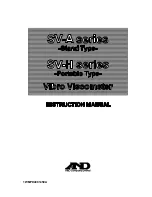
RBR#0008819revB
14
1.
2.
3.
4.
5.
6.
7.
8.
.
Replacing the O-rings
Correct placement and orientation of the two O-rings are critical to maintaining depth rating integrity.
The main O-ring has a round profile. It must be installed first.
The backup O-ring is flat on one side, and concave on the other. When installed, the concave side must face the main O-
ring.
Orientation of the O-rings (main O-ring, backup O-ring)
Use the plastic O-ring tool (included in the
) to remove the O-rings from the groove. The O-ring may
need to stretch quite a bit as it is pushed off. This requires some effort, but can be done by hand.
.
Clean the groove thoroughly with a soft, lint-free cloth and compressed air, if necessary.
Select the proper O-rings and inspect it for damage.
Lubricate with a very light film of silicone compound (included in the
Install the main O-ring by pushing it into place and popping it into its groove.
Install the backup O-ring, ensuring that the concave side is facing toward the main O-ring.
Once in place, inspect the O-rings once more for scratches and debris, and wipe away any silicone compound
deposited on the end-cap.
Once the inspection is complete,
.
•
•
•
•
When handling O-rings:
Avoid using any object that could scratch the O-ring or any of its mating surfaces.
If dirt is present in the O-ring groove, remove the O-ring as described below and thoroughly clean the
groove.
Do not return this old O-ring to the instrument! If you remove the O-ring from the instrument for any
reason, always replace it with a new one.
If the surfaces of the O-ring groove are scratched, pitted, or damaged, contact
Do not use metal screwdrivers or any other metal tool! They may scratch the O-ring groove and render the
end-cap useless.
main O-ring
backup O-ring
.








































